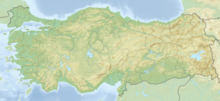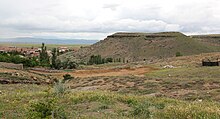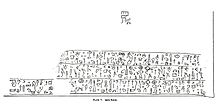Karaburna rock inscription
Coordinates: 38 ° 52 ′ 47.5 ″ N , 34 ° 27 ′ 18 ″ E
The rock inscription of Karaburna (also Karaburun ) is written in Luwian hieroglyphics and comes from the time of the late Hittite states . It is assigned to the Kingdom of Tabal and is believed to have been in the late 8th century BC. BC originated.
location
The inscription rock is located on a 90 meter high table mountain near Karaburna (also Karaburun) in the Hacıbektaş district of the Turkish province of Nevşehir , about ten kilometers southwest of the district town. The almost square plateau of the mountain has an area of about 90 × 90 meters. It shows clear traces of a fortress, the walls of which have been completely removed and probably built into the place at the foot of the hill. During a test excavation a little outside the walls in 1935 , Ignace Gelb first found Roman-Byzantine remains of terra sigillata and glass, a little deeper traces of Late Hittite and finally monochrome ceramics from the Alişar II period from the 2nd millennium BC at a depth of two meters . A stamp seal with geometric patterns that a villager found during the excavations on the slope indicates a probable settlement as early as the 3rd millennium BC. Chr.
From the south-west side of the hill, a footpath leads up the mountain in a north-easterly direction. At the point in the east, where the rock barrier surrounding the summit plateau has a gap, the gate of the fortification was probably located. A few meters to the left of it, the inscription is engraved on a rock at eye level.
Research history
The inscription was discovered in the summer of 1900 by the British epigrapher John George Clark Anderson on a trip to Asia Minor with the archaeologist John Winter Crowfoot. He published his find in 1901 as A new Hittite Inscription in the Journal of Hellenistic Studies . The next processing took place in 1902 by the German ancient orientalist Leopold Messerschmidt . In 1907, the participants of the Cornell expedition to Asia Minor and the Assyro-Babylonian Orient were on site and discovered other signs above the inscription that represent the scribe's signature. The first attempts at translation were made by the British archaeologist Archibald Henry Sayce in 1905 and the Czech Bedřich Hrozný , the decipherer of the Hittite cuneiform script, in 1934. After Yellow's excavations in 1935, a translation by Helmuth Theodor Bossert appeared in 1957 , who sharply criticized the interpretations of his predecessors. After the French linguist Emmanuel Laroche in 1956 and the Italian philologist Piero Meriggi in 1967, the British Hittitologist John David Hawkins finally provides the current translation in his Corpus of hieroglyphic Luwian inscriptions 2000. In 1988 Eberhard P. Rossner included the text in his archaeological guide to the Hittite rock reliefs in Turkey, and in 2014 the German architect Horst Ehringhaus published a detailed description with photos in his book on Luwian rock reliefs.
description
The inscription is a little more than a meter above the gently sloping ground in front of it. The main part is 1.54 meters wide and 0.42 meters high. There is also an extension on the left with 48 × 15 centimeters and the signature about 30 centimeters above the actual inscription. The main text consists of three lines, which are to be read boustrophedon at the top right . Since there was obviously insufficient space for the intended content, the text had to be ended on the left on a slightly angled area separated by a fraction. The characters are engraved and in legible condition, the lines are separated by dashes.
The text tells of a sealed contract between Sipi, the king and the eponymous Sipi, son of Ni, about the reconstruction of the fortress. It is divided into three parts. In the first it is reported that the fortress was in ruins and that King Si and Si, son of Ni , who had a high position at the court, rebuilt it and concluded the aforementioned treaty. In the second part the mutual threat of punishment follows:
If, however, Sipi, the king, wishes evil for Sipi, the son of Ni, for (his) son or grandson,
the arranean, like Kubaba of Sipi, the king, should devour the eyes and the feet.
as well as the corresponding for the counterpart. In the third part, the person who chisels away the inscription is threatened with similar punishments. The arranäer mentioned above refers to the moon god Sin von Harran , who has been worshiped there since the early 2nd millennium. The goddess Kubaba is also mentioned in the rock inscription by Bulgarian soldiers in a punitive capacity . The signature above the text names Wana, the writer .
A king by the name of Sipi is not otherwise known, it is probably a local ruler, possibly only this fortress. The inscription can therefore only be dated to the 8th century BC due to the shape of the signs. Take place.
literature
- JGC Anderson: A new Hittite Inscription In: The Journal of Hellenic Studies , Volume 21, 1901, pp. 322-324 ( digitized ).
- Benson Brush Charles: Hittite Inscriptions ( Cornell Expedition to Asia Minor ). Ithaca, New York 1911, pp. 11-13.
- Ignace Yellow: Hittite Hieroglyphic Monuments (= Oriental Institute Publications. Volume 45). The University of Chicago Press, Chicago 1939, p. 32.
- Eberhard P. Rossner: Rock monuments in Turkey. Volume 1: The Hittite rock reliefs in Turkey. An archaeological guide. 2nd, extended edition, Rossner, Munich 1988, ISBN 3-924390-02-9 , pp. 131-135.
- John David Hawkins: Corpus of hieroglyphic Luwian inscriptions . Volume 1. Inscriptions of the Iron Age . Part 1: Introduction, Karatepe, Karkamiš, Tell Ahmar, Maraş, Malatya, Commagene. Walter de Gruyter, Berlin 2000, ISBN 3-11-010864-X , pp. 480–483, plates 266–267.
- Horst Ehringhaus: The end that was a beginning. Rock reliefs and rock inscriptions of the Luwian states of Asia Minor from 12. to 8./7. Century BC Chr. Nünnerich-Asmus, Mainz 2014, ISBN 978-3-943904-67-3 , pp. 72-75.
Web links
- Karaburna on hittitemonuments.com
Individual evidence
- ^ Leopold Messerschmidt: Corpus inscriptionum Hettiticarum. First addendum (= messages from the Vorderasiatischen Gesellschaft . Volume 7, Issue 3). W. Peiser, Berlin 1902, pp. 17-19, plate XLVI.
- ^ Archibald Henry Sayce: The Hittite Inscriptions Translated an Annotated. In Proceedings of the Society of Biblical Archeology , Volume 27, 1905, pp. 217-219 ( digitized version ).
- ↑ Le Muséon , Volume 70, 1957, pp. 145-170.
- ↑ German translation quoted from Horst Ehringhaus: The end that was a beginning. Rock reliefs and rock inscriptions of the Luwian states of Asia Minor from 12. to 8./7. Century BC Chr. Nünnerich-Asmus, Mainz 2014, ISBN 978-3-943904-67-3 , p. 74.







